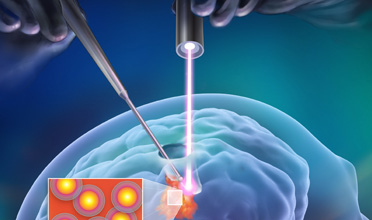Diffusion-Weighted Imaging in the Follow-Up of Treated High-Grade Gliomas: Tumor Recurrence Versus Radiation Injury

Abstract:
Diffusion-weighted
(DW) MR imaging is a means to characterize and differentiate morphologic
features, including edema, necrosis, and tumor tissue, by measuring differences
in apparent diffusion coefficient (ADC). These researchers hypothesized that DW
imaging has the potential to differentiate recurrent or progressive tumor
growth from treatment- induced damage to brain parenchyma in high-grade gliomas
after radiation therapy.
References:
[1.] Brandsma, D., Stalpers, L., Taal, W., et al (2008) .
Clinical features, mechanisms, and management of pseudoprogression in malignant
gliomas. The Lancet Oncology, 9(5), 453-461.
[2.] Brismar, J., Roberson, G.H., Davis, K.R (1976).
Radiation necrosis of the brain. Neuroradiological considerations with computed
tomography. Neuroradiology, 12(2), 109-113
[3.] Chamberlain, M.C., Glantz, M.J., Chalmers, L., et al
(2007) . Early necrosis following concurrent Temodar and radiotherapy in
patients with glioblastoma. - Journal of Neuro oncology, 82(1), 81-83.
[4.] Curnes, J., Laster, D., Bal,l M., et al (1986) . MRI
of radiation injury to the brain. Am J Roentgenol, 147(1), 119-124.
[5.] Dellen, J.v., Danzinger, A (1978). Failure of
computerized tomography to differentiate between radiation necrosis and
cerebral tumor. S Afr Med J, 53(5), 171-172.
[6.] Henson, J.W., Ulmer, S., Harris, G.J (2008). Brain
tumor imaging in clinical trials. Am J Neuroradiol, 29(3), 419-424.
[7.] Jain, R., Scarpace, L., Ellika, S., et al (2010).
Imaging response criteria for recurrent gliomas treated with bevacizumab: Role
of diffusion weighted imaging as an imaging biomarker. Journal of
Neuro-Oncology ,96(3),423-431.
[8.] Kato, T., Yutaka, S., Tada, M., et al (1996). Long
term evaluation of Radiation-induced brain damage by serial magnetic resonance
imaging. Neurologia Medico-Chirurgica, 36(12), 870-876.
[9.] Kumar, A.J., Leeds, N.E., Fuller, G.N., et al (2000).
Malignant gliomas: MR imaging spectrum of radiation therapy- and
chemotherapy-induced necrosis of the brain after treatment. Radiolog, ;217(2),
377-384.
[10.] Lyubimova, N., Hopewell , J.W, (2004). Experimental
evidence to support the hypothesis that damage to vascular endothelium plays
the primary role in the development of late radiation-induced CNS injury. Br
J Radiol; 77(918), 488-492.
[11.] Macdonald, D.R., Cascino, T.L., Schold, S.C., et al,
(1990). Response criteria for phase II studies of supratentorial malignant
glioma. Journal of Clinical Oncology, 8(7), 1277-1280.
[12.] Mikhael, M. (1978).Radiation necrosis of the brain:
correlation between computed tomography, pathology, and dose distribution. J
comput Assist Tomogr, 2(1), 71-80.
[13.] Mullins, M.E., Barest, G.D., Schaefer, P.W., et al
(2005). Radiation necrosis versus glioma recurrence: conventional MR imaging
clues to diagnosis. AJNR Am J Neuroradiol , 26(8), 1967-1972.
[14.] Sorensen, A.G., Batchelor, T.T., Wen, P.Y., et al
(2008). Response criteria for glioma. Nat Clin Prac Oncol, 5(11),
634-644.
[15.] Wen P.Y., Macdonald, D.R., Reardon, D.A., et al
(2010). Updated response assessment criteria for high-grade gliomas: response
assessment in neuro-oncology working group. Journal of Clinical Oncology,
28(11), 1963-1972.
[16.]
Zuniga,
R., Torcuator, R., Jain, R., et al (2009). Efficacy, safety and patterns of
response and recurrence in patients with recurrent high-grade gliomas treated
with bevacizumab plus irinotecan. Journal of Neuro-Oncology, 91(3),329

